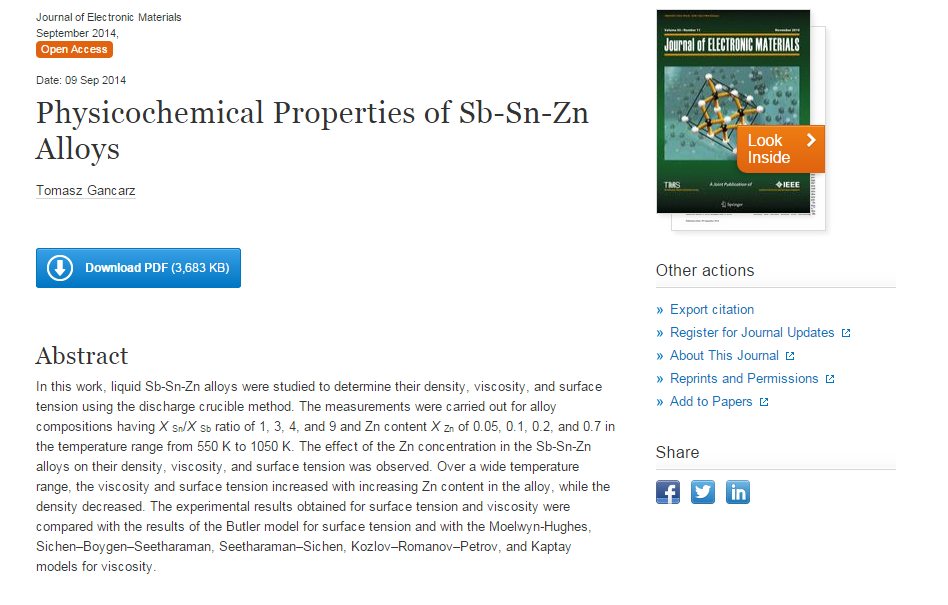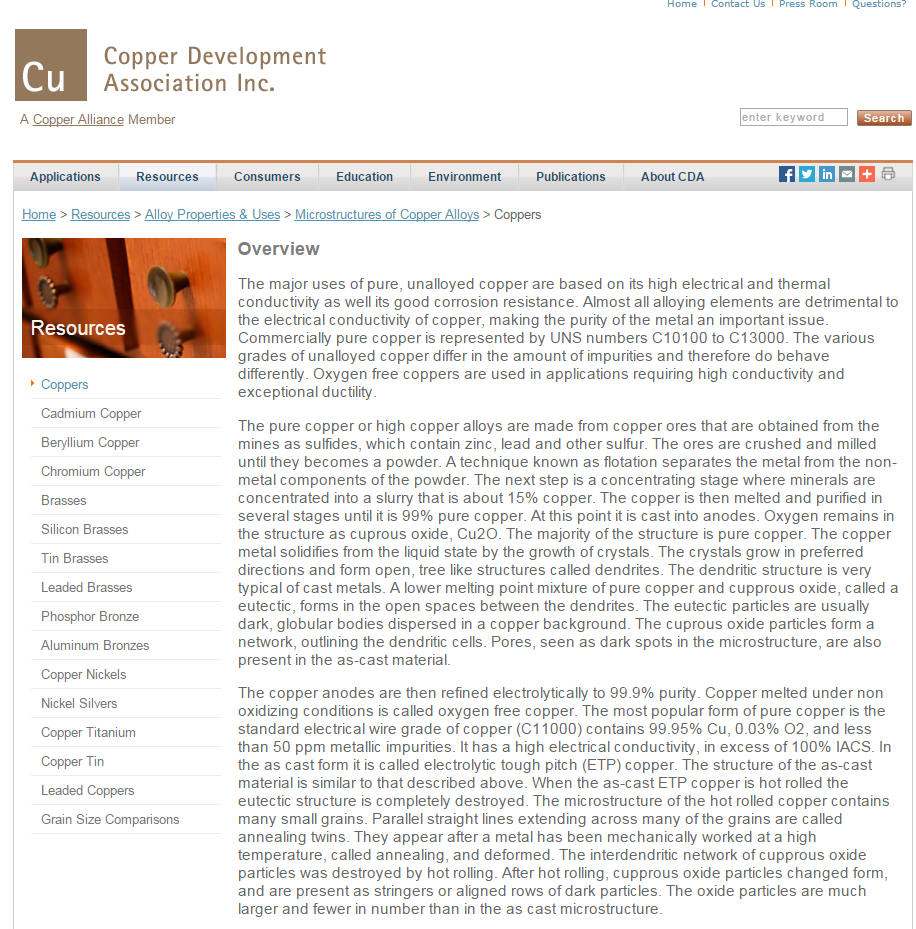[A Course in Metallurgy, Fabio Miani, University of Udine, Italy ]
This Course on Metallurgy is basically
a compromise between the good old school of teaching Metallurgy and new
available (free for up to three components!)
software Pandat Software (http://www.computherm.com/
last release October 2014) for phase diagram calculations.
The
student will be able to have a deeper
understanding of the subject by learning to use a Calphad
based software, Pandat. Understanding of the subject will be obtained
also by using other general purpose
software like Matlab or Maple) and by solving some
the problems the textbook proposes.
Course organization
There will be less powerpoint
slides projection as generally students would expect. Learning will be based
mainly on solving specific issues, and
generalized/categorized afterwards.
Materials
It is necessary to have a computer (Windows
based or otherwise installed by virtualization) to install Pandat.
Textbook is: Modern Physical
Metallurgy, 8th edition, by Smallman and Ngan, Butterworth-Heinemann ( Elsevier) .
Additional information on Mechanical
Metallurgy could be obtained by Dieter, Mechanical Metallurgy
Prerequisites and co-requisites
The student should already possess some elementary notions of materials science and mechanical behaviour
of metals and, possibly, metallurgy. In the case of a serious lack of
this information expecially for the mechanical
behaviour of metals, he/she should consider the materials in the first parts of
the above mentioned Dieter textbook.
Course
requirements
The student will provide in due
times assignements
( by email to metallurgia16@gmail.com )related to the use of Pandat
and solutions to selected problems during the course. Partecipation is
strongly recommended. Final
exam is needed in case of uncorrect or untimely
delivery of assignments and problems. A
specific final project will be proposed during the course.
The final grade student will be based mainly ( 80%- even 90 %)
on the involvement that the student has demonstrated by working out assignements and problems during the course. In case some
recovery is needed from a mark considered low by the student, final project
work will be considered by professor up
to 20%.
Course policies
and expectations
As laptop use is necessary,
an intelligent and respectful use of contemporary devices is welcome.
Course calendar
Will
be communicated ( by email) and published at www.gotrawama.eu/metallurgia/
Readings ( and suggested links ) should
be approached briefly before classroom. Emphasis in not on memorization, but on
the ability to solve (close to real world) problems
First week
STEP 0 Purpose and aim of the course
Lesson 1: Overview of the Course - Learning needs discussion and evaluation.
Historical, Economic, and Social Perspectives of the metal related activities.
Review
of Selected Global Mineral Industries in 2011 and an Outlook to 2017

http://www.gotrawama.eu/metallurgia/globalmineralindustries.htm
Metal
prices in the United States through 2010
http://www.gotrawama.eu/metallurgia/metal%20prices

Lesson 2: Metals and
materials. What is a metal in a elementary perspective.
Mineral Facilities of Europe

http://pubs.usgs.gov/of/2010/1257/
Readings: Chapter 1: Process Metallurgy�An Argosy Through Time
http://web.a.ebscohost.com/ehost/ebookviewer/ebook/bmxlYmtfXzQ4NTE4MV9fQU41?sid=85dc640b-a9f0-4446-9329-ccdb298881be@sessionmgr4001&vid=0&format=EB&lpid=lp_15&rid=0
Metal extraction procedures
from an elementary perspective.
Readings: Chapter 1.1: Introduction to Metallurgical
Processing
http://web.a.ebscohost.com/ehost/ebookviewer/ebook/bmxlYmtfXzQ4NTE4MV9fQU41?sid=85dc640b-a9f0-4446-9329-ccdb298881be@sessionmgr4001&vid=0&format=EB&lpid=lp_15&rid=0#
Metal oxydes
and metal recycling: a way to a greener production.
Lesson 3: Pandat software
and metallurgical thermochemistry

Using Pandat Basics: http://www.computherm.com/
Use of Pandat for the Li.Si phase diagram: paper from Maria Helena Braga, Oporto,
Portugal - http://paginas.fe.up.pt/~mbraga/the_group.html

Elements (2)
|
Name |
Structure |
Atomic
Number |
Atomic
Weight |
H298 |
S298 |
|
LI |
BCC_A2 |
3 |
6.941 |
4623.3 |
29.095 |
|
SI |
DIAMOND_A4 |
14 |
28.085 |
3217.5 |
18.82 |
Phases (10)
|
Name |
Model |
Type_Def Code |
Lattice
Size |
Constituent |
|
BCC_A2 |
CEF (SLN) |
|
(1)(3) |
(LI,SI)(VA) |
|
DIAMOND_A4 |
CEF (SLN) |
|
(1) |
(LI,SI) |
|
LI12SI7 |
CEF (ST2) |
|
(0.6316)(0.3684) |
(LI)(SI) |
|
LI13SI4 |
CEF (ST2) |
|
(0.7647)(0.2353) |
(LI)(SI) |
|
LI17SI4 |
CEF (ST2) |
|
(0.8095)(0.1905) |
(LI)(SI) |
|
LI21SI5 |
CEF (ST2) |
|
(0.80769)(0.19231) |
(LI)(SI) |
|
LI4_13SI |
CEF (ST2) |
|
(0.80488)(0.19512) |
(LI)(SI) |
|
LI7SI3 |
CEF (ST2) |
|
(0.7)(0.3) |
(LI)(SI) |
|
LIQUID |
CEF (SLN) |
|
(1) |
(LI,SI) |
|
LISI |
CEF (ST2) |
|
(0.5)(0.5) |
(LI)(SI) |
Phase Parameters
|
Name |
Property |
x-Term |
x-order |
Parameter |
T-limit
(K) |
|
BCC_A2 |
L0 |
(LI)(VA) |
0 |
+GHSERLI |
6000 |
|
L0 |
(SI)(VA) |
0 |
+30225.0-9.59*T+GHSERSI |
6000 |
|
|
L |
(LI,SI)(VA) |
0 |
+0 |
6000 |
|
|
DIAMOND_A4 |
L0 |
(LI) |
0 |
+26963.2+15.83*T+GHSERLI |
6000 |
|
L0 |
(SI) |
0 |
+GHSERSI |
6000 |
|
|
L |
(LI,SI) |
0 |
+0 |
6000 |
|
|
LI12SI7 |
L0 |
(LI)(SI) |
0 |
-24817+2.49*T
+0.6316*GHSERLI+0.3684*GHSERSI |
6000 |
|
LI13SI4 |
L0 |
(LI)(SI) |
0 |
-25207+4.15*T
+0.7647*GHSERLI+0.2353*GHSERSI |
6000 |
|
LI17SI4 |
L0 |
(LI)(SI) |
0 |
-22818+4.997*T
+0.8095*GHSERLI+0.1905*GHSERSI |
6000 |
|
LI21SI5 |
L0 |
(LI)(SI) |
0 |
-22683+4.608*T
+0.80769*GHSERLI+0.19231*GHSERSI |
6000 |
|
LI4_13SI |
L0 |
(LI)(SI) |
0 |
-23045.5+4.79*T
+0.80488*GHSERLI+0.19512*GHSERSI |
6000 |
|
LI7SI3 |
L0 |
(LI)(SI) |
0 |
-26700+3.11*T
+0.700*GHSERLI+0.300*GHSERSI |
6000 |
|
LIQUID |
L0 |
(LI) |
0 |
-7883.612+211.841861*T
-38.940488*T*LN(T)+.035466931*T**2 -1.9869816E-05*T**3+159994*T**(-1) |
250 |
|
+12015.027-362.187078*T+61.6104424*T*LN(T)-.182426463*T**2
+6.3955671E-05*T**3-559968*T**(-1) |
453.6 |
||||
|
-6057.31+172.652183*T-31.2283718*T*LN(T)+.002633221*T**2
-4.38058E-07*T**3 -102387*T**(-1) |
3000 |
||||
|
L0 |
(SI) |
0 |
+50696.4-30.0994*T
+2.09307E-21*T**7+GHSERSI |
1687 |
|
|
+49828.2-29.5591*T+4.20369E+30*T**(-9)+GHSERSI |
6000 |
||||
|
L |
(LI,SI) |
0 |
-115035+23*T |
6000 |
|
|
L |
(LI,SI) |
1 |
-55980+17*T |
6000 |
|
|
L |
(LI,SI) |
2 |
+9764 |
6000 |
|
|
L |
(LI,SI) |
3 |
+35653 |
6000 |
|
|
LISI |
L0 |
(LI)(SI) |
0 |
-19789+2.1599*T
+0.5*GHSERLI+0.5*GHSERSI |
6000 |
Functions
|
Name |
Expression |
T-limit
(K) |
|
GBCCSI |
+30225.0-9.59*T+GHSERSI |
6000 |
|
GHSERLI |
-10583.817+217.637482*T-38.940488*T*LN(T)
+.035466931*T**2-1.9869816E-05*T**3+159994*T**(-1) |
453.6 |
|
-559579.123+10547.8799*T-1702.88865*T*LN(T)+2.25832944*T**2
-5.71066077E-04*T**3+33885874*T**(-1) |
500 |
|
|
-9062.994+179.278285*T-31.2283718*T*LN(T)+.002633221*T**2
-4.38058E-07*T**3-102387*T**(-1) |
3000 |
|
|
GHSERSI |
-8162.609+137.236859*T-22.8317533*T*LN(T)
-1.912904E-3*T**2-0.003552E-6*T**3+176667*T**(-1) |
1687 |
|
-9457.642+167.281367*T-27.196*T*LN(T)
-420.369E28*T**(-9) |
3600 |
|
|
UN_ASS |
0 |
300 |
http://www.gotrawama.eu/metallurgia/LiSi.htm

Li-Si Phase Diagram from the
Paper

Li-Si Phalse Diagram using only SGTE (pure
metals) data
Possible Digression on
Alkali Metals: https://en.wikipedia.org/wiki/Alkali_metal
Possible readings: 1
Atoms and Atomic Arrangements http://web.b.ebscohost.com/ehost/ebookviewer/ebook/bmxlYmtfXzQ4NjI4NF9fQU41?sid=6ad42165-2929-43aa-9ba9-095878d321c1@sessionmgr112&vid=0&format=EB&lpid=lp_1&rid=0#
(Second Week) Lesson 4: Another Pandat Simulation of Li-Sn
phase diagram.
http://www.gotrawama.eu/metallurgia/LiSn.htm
Elements (2)
|
Name |
Structure |
Atomic
Number |
Atomic
Weight |
H298 |
S298 |
|
LI |
BCC_A2 |
3 |
6.941 |
4623.3 |
29.095 |
|
SN |
BCT_A5 |
50 |
118.71 |
6322 |
51.195 |
Species (1)
|
Name |
Formula |
Charge |
|
LI4SN |
(LI)4(SN)1 |
0 |
Type
Definition (1)
|
Type
Code |
Function |
Phase |
Property |
Parameter |
|
& |
AMEND_PHASE_DESCRIPTION |
BCC_A2 |
MAGNETIC |
(-1) (0.4) |
Phases (4)
|
Name |
Model |
Type_Def Code |
Lattice
Size |
Constituent |
|
BCC_A2 |
CEF (SLN) |
& |
(1)(3) |
(LI,SN)(VA) |
|
BCT_A5 |
CEF (ST1) |
|
(1) |
(SN) |
|
DIAMOND_A4 |
CEF (ST1) |
|
(1) |
(SN) |
|
LIQUID |
CEF (SLN) |
|
(1) |
(LI,LI4SN,SN) |
Phase Parameters
|
Name |
Property |
x-Term |
x-order |
Parameter |
T-limit
(K) |
|
BCC_A2 |
L0 |
(LI)(VA) |
0 |
+GHSERLI |
3000 |
|
L0 |
(SN)(VA) |
0 |
+GBCCSN |
3000 |
|
|
BCT_A5 |
L0 |
(SN) |
0 |
+GHSERSN |
3000 |
|
DIAMOND_A4 |
L0 |
(SN) |
0 |
-9579.608+114.007785*T
-22.972*T*LN(T)-.00813975*T**2+2.7288E-06*T**3+25615*T**(-1) |
298.15 |
|
-9063.001+104.84654*T-21.5750771*T*LN(T)-.008575282*T**2
+1.784447E-06*T**3-2544*T**(-1) |
800 |
||||
|
-10909.353+147.396537*T-28.4512*T*LN(T) |
3000 |
||||
|
LIQUID |
L0 |
(LI) |
0 |
+GLIQLI |
3000 |
|
L0 |
(LI4SN) |
0 |
-205264.343+187.457195*T
-16.7055876*T*LN(T)+4*GLIQLI+GLIQSN |
3000 |
|
|
L0 |
(SN) |
0 |
+GLIQSN |
3000 |
|
|
L |
(LI,SN) |
0 |
-64124.4038-15.9626763*T
+2.04164413*T*LN(T) |
3000 |
|
|
L |
(LI,LI4SN) |
0 |
30074.1641-19.0031351*T
-1.46094182*T*LN(T) |
3000 |
|
|
L |
(LI4SN,SN) |
0 |
-24652.1452-259.57801*T
+28.4690441*T*LN(T) |
3000 |
Functions
|
Name |
Expression |
T-limit
(K) |
|
GBCCSN |
+GHSERSN+4400-6*T |
3000 |
|
GFCCLI |
+GHSERLI-108+1.3*T |
3000 |
|
GFCCSN |
+GHSERSN+5510-8.46*T |
3000 |
|
GHCPLI |
+GHSERLI-154+2*T |
3000 |
|
GHCPSN |
+GHSERSN+3900-7.646*T |
3000 |
|
GHSERLI |
-10583.817+217.637482*T-38.940488*T*LN(T)
+.035466931*T**2-1.9869816E-05*T**3+159994*T**(-1) |
453.6 |
|
-559579.123+10547.8799*T-1702.88865*T*LN(T)+2.25832944*T**2
-5.71066077E-04*T**3+33885874*T**(-1) |
500 |
|
|
-9062.994+179.278285*T-31.2283718*T*LN(T)+.002633221*T**2
-4.38058E-07*T**3-102387*T**(-1) |
3000 |
|
|
GHSERSN |
-7958.517+122.765451*T-25.858*T*LN(T)
+5.1185E-04*T**2-3.192767E-06*T**3+18440*T**(-1) |
250 |
|
-5855.135+65.443315*T-15.961*T*LN(T)-.0188702*T**2+3.121167E-06*T**3
-61960*T**(-1) |
505.08 |
|
|
+2524.724+4.005269*T-8.2590486*T*LN(T)-.016814429*T**2
+2.623131E-06*T**3-1081244*T**(-1)-1.2307E+25*T**(-9) |
800 |
|
|
-8256.959+138.99688*T-28.4512*T*LN(T)-1.2307E+25*T**(-9) |
3000 |
|
|
GLIQLI |
-7883.612+211.841861*T-38.940488*T*LN(T)
+.035466931*T**2-1.9869816E-05*T**3+159994*T**(-1) |
250 |
|
+12015.027-362.187078*T+61.6104424*T*LN(T)-.182426463*T**2
+6.3955671E-05*T**3-559968*T**(-1) |
453.6 |
|
|
-6057.31+172.652183*T-31.2283718*T*LN(T)+.002633221*T**2
-4.38058E-07*T**3-102387*T**(-1) |
3000 |
|
|
GLIQSN |
+GHSERSN+7103.092-14.087767*T
+1.47031E-18*T**7 |
505.08 |
|
+9496.31-9.809114*T-8.2590486*T*LN(T)-.016814429*T**2
+2.623131E-06*T**3-1081244*T**(-1) |
800 |
|
|
-1285.372+125.182498*T-28.4512*T*LN(T) |
3000 |
|
|
UN_ASS |
0.0 |
300 |

Readings:The good old school.. Phase
Diagrams and alloy Theory


Li-Sn
Phase Diagram
Digression: Various
Activities of Prof. Sadoway at MIT Digression: Is
This Ambri’s
New Liquid-Metal Battery Materials Formula?

Lesson 5: A more complicated
situation, a ternary phase diagram. The case of Cu Sn
Zn.
http://www.sciencedirect.com/science/article/pii/S0925838808019816


Liquidus projection Cu-Sn-Zn
and Liquidus
Surface

Lesson 6: It seems easier: the case of Sn-Zn, Cu-Zn
phase diagrams


|
Readings: Chapter 5
Characterization and Analysis. Problems Chapter 5. |
|
|
|
|
Lesson
7: The case of Cu-Sn. Copper alloys: brasses bronzes
and much more

Lesson 8: More and more
difficult - the quaternary Al-Cu-Si-Mg and quinary Al-Cu-Si-Mg-Mn . Checking the open data that we have.. with binaries and ternaries with the “professional” version
of Pandat (8.2)

http://www.sciencedirect.com/science/article/pii/S0040603110003990
Lesson 9: Al-Cu-Si ternary. Aluminum alloys

http://www.sciencedirect.com/science/article/pii/S092583881101913X
Lesson 10: Physical
Properties Readings: Chapter 8 Problems Chapter 8
|
|
|
|
Work of Gancarz based on Henein-Roach viscosimeter

Lesson
11 : Plastic Deformation and Dislocation Behaviour Reading: Chapter 9 Problems
Chapter 9
|
|
|
|
Additional Readings: Dieter
Mechanical Metallurgy

https://archive.org/stream/mechanicalmetall00diet#page/n5/mode/2up

https://archive.org/stream/mechanicalmetall00diet#page/n25/mode/2up
“.. for students of
engineering who have had an advanced course on strength of materials or machine
design, it probably will be possible to skim rapidly over these chapters..”
Readings: Learning Dieter
Dislocation Theory.. Not the easiest thing to do!!

https://archive.org/stream/mechanicalmetall00diet#page/158/mode/2up
Lesson 12 : Surfaces, Grain
Boundaries and Interfaces Reading: Chapter 10 Problems Chapter 10


Lesson 13 : Work hardening
and annealing : Chapter 11 Problems Chapter 11

Lesson 14 : Did we forget about something? Reading: Chapter 14 Selected Alloys
Problems Chapter 14

The textbook reports on
steels, cast irons, superalloys, titanium alloys,
structural intermetallic compounds, aluminium alloys,
copper and copper alloys.. I would add magnesium alloys.. the Science Direct (Elsevier) journal of
magnesium and alloys is open access!! http://www.sciencedirect.com/science/journal/22139567
The textbook reports on steels, cast irons,superalloys, titanium alloys, copper and copper alloys.. I would add magnesium alloys..
The Science Direct (Elsevier) journal of magnesium and alloys is open access!!

Technical and Commercial Information on Copper and Copper Alloys


Lesson 15: Phase Diagrams back! Fe-Cu-C, Fe-Cr-C, Fe-Cr-Ni phase diagrams. Yes,
there is also a Fe-C diagram..
Pandat Liquidus
Surface Fe-Cr-C

See also.. Madeleine Durand-Charre. The Microstructure of Steels and Cast Irons https://www.academia.edu/7563031/MADELEINE_DURAND-CHARRE._THE_MICROSTRUCTURE_OF_STEELS_AND_CAST_IRONS

Lesson 16 : Continuation of
15 and .. A world of steel: WorldSteel site
http://www.worldsteel.org Steeluniversity http://www.steeluniversity.org

Lesson 17/18/ Steel transformations
Chapter 12 Problems Chapter 12

Lesson 19 : Scientific and Technical aspects of steels. The case of steels for
bearings
After.. Prof. H.D.K. Bhadeshia, Cambridge ( and SKF University Technology Center for Steels http://www.msm.cam.ac.uk/phase-trans/2011/Bearings/)

And Ovako:
http://www.ovako.com/Global/Downloads/Product_information/Ovako_Group/EN/Steels%20for%20Bearings%20from%20Ovako.pdf

Lesson 20: - ideas and examples from Materials Science of Steel www.gotrawama.eu/Metallurgiaacciaio/ to develop final project







